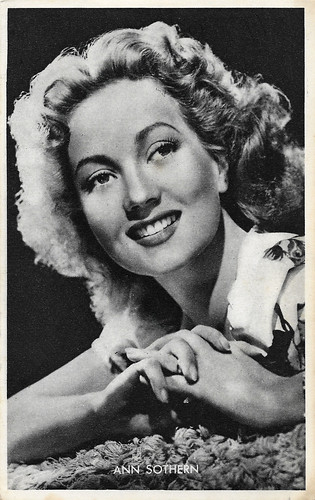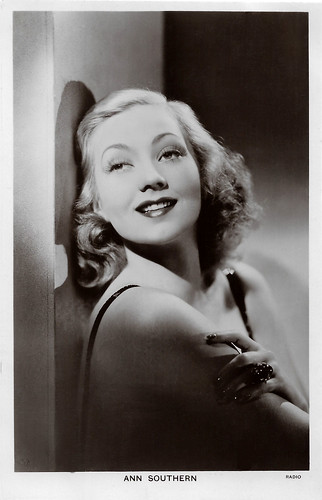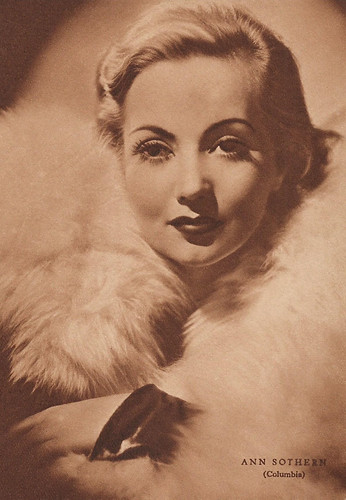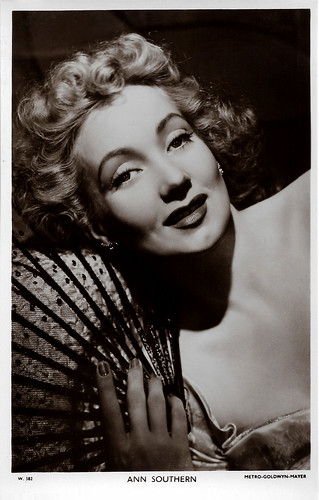
Belgian collectors card by Kwatta, no. C. 283. Photo: MGM. Ann Sothern in Shadow on the Wall (Pat Jackson, 1950).

Belgian collectors card by Kwatta, Bois-d'Haine, no. C. 122 (in the series C. 99-196). Photo: MGM.
Singer with Artie Shaw and His Orchestra
Ann Sothern was born Harriette Arlene Lake in 1909 in Valley City, North Dakota. She was the oldest of three daughters born to Walter J. Lake and Annette Yde. Her two younger sisters were Marion and Bonnie. Annette Yde was a concert singer, while Sothern's father worked in importing and exporting.
Harriette and her sisters were raised in Minneapolis, Minnesota. Her parents separated when she was four years old (they would later divorce in 1927). At the age of five, she began taking piano lessons. She later studied at the McPhail School of Music, where her mother also taught piano.
She also began accompanying her mother on her concert tours when her school schedule permitted. By age 11, she had become an accomplished pianist and was singing solos in her church choir.
At age 14, she began voice lessons and also continued to study piano and music composition. As a teen at Minneapolis Central High School, she appeared in numerous stage productions and also directed several shows. While visiting her mother in California, she won a role in the Warner Bros. revue The Show of Shows.
She did a screen test for MGM and signed a six-month contract. Her film career started as an extra in Broadway Nights (Joseph Boyle, 1927). She worked as an extra for the next six years. It barely paid the bills. As a singer, she performed with Artie Shaw and His Orchestra. She was also a published songwriter and recorded two albums.

Vintage postcard.

British postcard in the Picturegoer Series, no. W. 993a. Photo: Radio.
Maisie
Originally a redhead, Ann Sothern began to bleach her hair blonde for comedy roles. After working at MGM and on Broadway, Ann was signed by Columbia Pictures for Let's Fall in Love (David Burton, 1933). Harry Cohn changed her name to Ann Sothern.
The next year she would work with Eddie Cantor in his hit Kid Millions (Roy Del Ruth, 1934). Sothern would be in 11 "B" pictures until she was dropped by Columbia in 1936.
She then went to RKO, where the quality of her films did not improve. She appeared in a series of "B' films such as Dangerous Number (Richard Thorpe, 1937) and She's Got Everything (Joseph Santley, 1937) with Gene Raymond, but her career was going nowhere.
In 1938 she left RKO and played Jean Livingstone, the tart in Trade Winds (Tay Garnett, 1938), starring Fredric March and Joan Bennett, which got her a contract at MGM.
She was given the lead in Maisie (Edwin L. Marin, 1939), a "B" comedy about a brassy, energetic showgirl, not a salesgirl - a role originally intended for Jean Harlow. The character was based on the Maisie short stories by Nell Martin. Maisie (Edwin L. Marin, 1939) became a huge hit and spawned a series of ten films with the last being Undercover Maisie (Harry Beaumont, 1947). The popularity of the film series led to her own radio program, 'The Adventures of Maisie', broadcast on CBS from 1945 to 1947.

Italian postcard by Rizzoli & C., Milano, 1936. Photo: Columbia EIA.

Italian postcard by Rizzoli & C., Milano, 1938. Photo: Columbia Pictures.
My Mother the Car
Ann Sothern also appeared in such well-received features as Brother Orchid (Lloyd Bacon, 1940) with Edward G. Robinson, Cry 'Havoc' (Richard Thorpe, 1943) with Margaret Sullavan and Joan Blondell, and A Letter to Three Wives (Joseph L. Mankiewicz, 1949) with Linda Darnell and Jeanne Crain.
During the 1950s, she played in only four films, including Fritz Lang's Film Noir The Blue Gardenia (1953) with Anne Baxter. By this time, however, Sothern had turned to the relatively new medium - television, where she would attract legions of new fans.
She played the meddlesome Susie in the TV series Private Secretary (1953). Sothern was nominated for a Primetime Emmy Award for her role in the series four times. The series was cancelled in 1957 and Ann came back in The Ann Sothern Show (1958-1961).
After The Ann Sothern Show ended, she returned to the cinema in The Best Man (Franklin J. Schaffner, 1964), opposite Henry Fonda. She was nominated for Best Supporting Actress Golden Globe for her work in the film. In 1965, she had a recurring role on her friend Lucille Ball's The Lucy Show as the "Countess Framboise" (née Rosie Harrigan). She also would be the voice of the 1928 Porter in the camp classic My Mother the Car (1965). This TV series was about a man (Jerry Van Dyke) who bought a 1928 Porter and, lo and behold, it was "Mom".
The 1970s and 1980s were relatively quiet for Ann. She appeared in some B-films like the horror film The Killing Kind (Curtis Harrington, 1973) as the mother of psycho John Savage, but finally, she would be nominated for an Academy Award for her role as the neighbour of Lillian Gish and Bette Davis in The Whales of August (Lindsay Anderson, 1987). After, she lived in quiet retirement in Ketcham, Idaho near her daughter and granddaughter, until her death of heart failure at 92. Ann Sothern passed away in 2001 in Ketchum, Idaho.

British postcard in the Picturegoer Series, no. W. 382. Photo: MGM.
Sources: Tony Fontana (IMDb), Denny Jackson (IMDb), Wikipedia and IMDb.
No comments:
Post a Comment